- Anne Neville
-
For her mother, see Anne Neville, 16th Countess of Warwick.
Anne Neville 
Queen consort of England Tenure 26 June 1483 – 16 March 1485 Coronation 6 July 1483 Spouse Edward of Westminster, Prince of Wales
Richard III of EnglandIssue Edward of Middleham, Prince of Wales Father Richard Neville, 16th Earl of Warwick Mother Anne Neville, 16th Countess of Warwick Born 11 June 1456
Warwick Castle, WarwickshireDied 16 March 1485 (aged 28)
Westminster, LondonBurial Westminster Abbey, London Lady Anne Neville (11 June 1456 – 16 March 1485) was Princess of Wales as the wife of Edward of Westminster and Queen of England as the consort of King Richard III. She held the latter title for less than two years, from 26 June 1483 until her death in March 1485. She had just one son, Edward, whom she outlived.
Anne was a member of the powerful northern English Neville family, being the younger daughter of Richard Neville, 16th Earl of Warwick, called in history, "The Kingmaker". As a result of this, she was used to strengthen the alliance between her father and Margaret of Anjou during the dynastic civil wars known as the Wars of the Roses fought between the houses of York and Lancaster.
Contents
Early life
Lady Anne was born at Warwick Castle, the younger daughter of Richard Neville, 16th Earl of Warwick and Anne Neville, 16th Countess of Warwick. Throughout her life, she would be used as a political pawn. Much of her childhood was spent at Middleham Castle, one of her father's properties, where she and her elder sister, Isabella, met the younger sons of Richard, Duke of York. These boys would play a major role in the destiny of both sisters.
Princess of Wales
At 14, Anne was betrothed by her father to Richard, youngest brother of Yorkist king Edward IV of England; he would later be Richard III of England. Anne's father, dissatisfied with the rewards he had received for helping Edward gain the throne, compared with the favours lavished on the Woodville family, changed sides and allied himself with Margaret of Anjou, Queen consort of the ousted Lancastrian king Henry VI. Margaret harboured suspicions about Warwick's motives, particularly since Anne's sister, Isabel, was married to the reigning king's brother, George, Duke of Clarence.
As part of the formal agreement, Anne was formally betrothed to Queen Margaret's son, Edward of Westminster at the Chateau d'Amboise in France, and married in Angers Cathedral probably on 13 December 1470.
The Earl of Warwick, who had been dispatched by Margaret to England to restore King Henry to the throne, succeeded in this task but was defeated and killed in battle a few months later. Anne arrived back in England with her new husband and mother-in-law to find herself fatherless.
With the death of Prince Edward at the Battle of Tewkesbury on 4 May 1471, she was taken prisoner along with Queen Margaret. She was taken first to Coventry and then to the Duke of Clarence's house in London, where she became the subject of some dispute between Clarence and Richard. Since she and her sister Isabel were heiresses to their father's Neville estates, her sister and Clarence were not keen to see her married and strengthen her position to claim them. The king refused her safe conduct to plead her case and she wrote to Queen Elizabeth, Elizabeth of York and several others to no avail.[1]
There are various accounts of what happened subsequently, including the story that she escaped from Clarence's custody and sought refuge in a London cookshop disguised as a servant.[2]
Clarence, married to Anne's sister and anxious to secure the whole Neville inheritance, treated her as his ward. His brother, Richard (later Richard III of England) is said to have tracked her down and escorted her to sanctuary at the Church of St Martin le Grand. They were married early next year and left for Middleham Castle.
Duchess of Gloucester
The wedding of Anne Neville and Richard, Duke of Gloucester (subsequently Richard III of England) took place on 12 July 1472, at Westminster Abbey, and they made their marital home in the familiar surroundings of Middleham Castle, Richard having been appointed Governor of the North on the king's behalf. Upon her marriage, she was styled Duchess of Gloucester. They had only one child, Edward, born at Middleham in around 1473.
Queen consort of England
 Anne Neville's arms as Queen consort[3]
Anne Neville's arms as Queen consort[3]
On 9 April 1483, Edward IV died. Richard was named Lord Protector for his 12-year-old nephew Edward V. However, on 25 June 1483, Edward and his siblings were declared illegitimate, and Richard ascended the throne as King Richard III. Anne was crowned on 6 July 1483 by Thomas Bourchier, Archbishop of Canterbury, and her son was created Prince of Wales. She was accompanied by less than half the knights that her predecessor had, which might have reflected the reluctance of many to embrace the new regime.
She was on good terms with her mother-in-law, Cecily Neville, Duchess of York, with whom she discussed religious works, such as the one written by Mechtilde of Hackeborn.[4]
Edward of Middleham died suddenly on 9 April 1484, at Sheriff Hutton, while his parents were absent. He was then 11 years old.
After the death of his son and heir, rumours arose that Richard planned to divorce Anne and marry his niece, Elizabeth of York. There is little evidence for this, however, and none at all for the later rumour that he had poisoned Anne.
After the death of her son, Anne effectively adopted Richard's nephew, Edward, Earl of Warwick, the nine-year-old son of George of Clarence. Richard made the boy his heir, probably in deference to Anne's wishes. Edward of Warwick was described as "simple-minded", and after Anne died, Richard promptly named another nephew — John de la Pole, Earl of Lincoln — as his heir.
Death
Anne died on 16 March 1485 of tuberculosis, at Westminster. The day she died, there was an eclipse, which some took to be an omen of Richard's fall from heavenly grace. She was buried in Westminster Abbey, in an unmarked grave to the right of the High Altar, next to the door to the Confessor's Chapel. Richard openly wept at her funeral. There was no memorial to her until the late 20th century, when a bronze tablet was erected on a wall near her grave by the Richard III Society in 1960.
Depictions in fiction
Anne appears in three scenes in William Shakespeare's Richard III, in the early scenes when Richard persuades her to marry him, in one brief scene just before Richard's coronation, and towards the end of the play as a ghost. She is portrayed by Claire Bloom in Laurence Olivier's 1955 film adaptation of the play, Kristin Scott Thomas in Ian McKellen's 1995 adaptation of the play and by Winona Ryder in the 1996 movie Looking for Richard. In the play, Richard woos her as she stands mourning over the coffin of her father-in-law King Henry VI, whom Richard killed. After Richard becomes King, he arranges for Anne to be poisoned so that he can marry his niece Elizabeth.
Anne is portrayed by Rose Hobart in the 1939 film Tower of London, and by Joan Camden in the 1962 remake. The story of Anne and Richard is portrayed in the 1982 novel The Sunne in Splendour by Sharon Kay Penman, which presents a sympathetic portrayal of Richard. The early lives of Anne and Richard are dramatised in parallel fashion in Rhoda Edwards' Fortune's Wheel and their marriage and last years in The Broken Sword (alternately Some Touch of Pity), both published in the 1970s. Desire the Kingdom: A Story of the Last Plantagenets (2002), by Paula Simonds Zabka, features Anne as the protagonist in a story set towards the end of the Wars of the Roses. The book The Reluctant Queen: The Story of Anne of York is by Jean Plaidy. She is the main character of Jan Westcott's Set Her on a Throne (1972).
Anne and Richard's romance is the centerpiece for Anne O'Brien's novel, The Virgin Widow. The novel is told in first person by Anne herself and follows the events firsthand from the time she first met Richard at her family's estate in Middleham to the time her son is born in 1472. The novel is a romantic historical account of the War of the Roses, portraying Richard Plantagenet as a heroic, romantic figure.
Ancestry
Sources
- ^ Hilton, Lisa (2008). Queens Consort, England's Medieval Queens. Great Britain: Weidenfeld & Nichelson. p. 444. ISBN 978-0-7538-2611-9.
- ^ Paul Murray Kendall, Richard The Third, George Allen & Unwin Ltd., London, 1955, p.108
- ^ Boutell, Charles (1863), A Manual of Heraldry, Historical and Popular, London: Winsor & Newton, pp. 277
- ^ Hilton, Lisa (2008). p. 456.
References
- Michael Hicks, Anne Neville: Queen to Richard III, Tempus 2006.
English royalty Vacant Title last held byElizabeth WoodvilleQueen consort of England
Lady of Ireland
26 June 1483 – 16 March 1485Vacant Title next held byElizabeth of YorkPrincesses of Wales Camilla Shand (2005 – present)
Lady Diana Spencer (1981–1997) · Mary of Teck (1901–1910) · Alexandra of Denmark (1863–1901) · Caroline of Brunswick (1795–1820) · Augusta of Saxe-Gotha (1736–1751) · Caroline of Brandenburg-Ansbach (1714–1727) · Catherine of Aragon (1501–1502) · Anne Neville (1470–1471) · Joan of Kent (1361–1376) · Eleanor de Montfort (pre-conquest) (c. 1252–1282)English Royal Consorts Matilda of Flanders (1066–1083) · Matilda of Scotland (1100–1118) · Adeliza of Louvain (1121–1135) · Matilda I of Boulogne (1135–1152) · (Geoffrey V of Anjou?) (1141) · Eleanor of Aquitaine (1154–1189) · Margaret of France (1172–1183) · Berengaria of Navarre (1191–1199) · Isabella of Angoulême (1200–1216) · Eleanor of Provence (1236–1272) · Eleanor of Castile (1272–1290) · Margaret of France (1299–1307) · Isabella of France (1308–1327) · Philippa of Hainault (1328–1369) · Anne of Bohemia (1383–1394) · Isabella of Valois (1396–1399) · Joanna of Navarre (1403–1413) · Catherine of Valois (1420–1422) · Margaret of Anjou (1445–1471) · Elizabeth Woodville (1464–1483) · Anne Neville (1483–1485) · Elizabeth of York (1486–1503) · Catherine of Aragon (1509–1533) · Anne Boleyn (1533–1536) · Jane Seymour (1536–1537) · Anne of Cleves (1540) · Catherine Howard (1540–1542) · Catherine Parr (1543–1547) · (Lord Guilford Dudley?) (1553) · Anne of Denmark (1603–1619) · Henrietta Maria of France (1625–1649) · Catherine of Braganza (1662–1685) · Mary of Modena (1685–1688) · George of Denmark (1702–1707)House of Plantagenet Titles Count of Gâtinais (origin) · Count of Anjou · Count of Maine · King of Jerusalem (claim) · Duke of Aquitaine · Duke of Normandy · King of England · Lord of Ireland · Duke of Brittany · Lord of Cyprus · Prince of Wales · King of the Romans (claim) · King of France (claim) · King of Sicily (claim) · King of Castile (claim) Armorial of Plantagenet
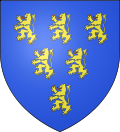
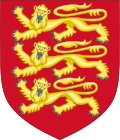
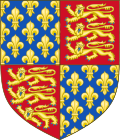
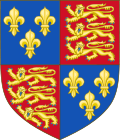

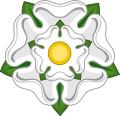
Branches Monarchs,
their queens
and issueSpouse: Eleanor of Aquitaine
William IX, Count of Poitiers · Henry the Young King · Richard I of England · Geoffrey, Duke of Brittany · Matilda of England, Duchess of Saxony · Eleanor, Queen of Castile · Joan, Queen of Sicily · John, King of England
Illegitimates: William de Longespée, Earl of Salisbury · Geoffrey, Archbishop of YorkQueen consort: Margaret of France
William (died in infancy)Spouse: Berengaria of Navarre
Illegitimates: Philip of CognacJohn, King of EnglandSpouse: Isabella of Angoulême
Henry III of England · Richard, Earl of Cornwall · Joan, Queen of Scots · Isabella, Holy Roman Empress · Eleanor
Illegitimates: Joan, Lady of Wales · Richard FitzRoy · Oliver FitzRoy · Geoffrey FitzRoy · John FitzRoy · Henry FitzRoy ·
Osbert Gifford · Eudes FitzRoy · Bartholomew FitzRoy · Maud FitzRoy · Isabel FitzRoy · Philip FitzRoy · William de ForzSpouse: Eleanor of Provence
Edward I of England · Margaret, Queen of Scots · Beatrice, Duchess of Brittany · Edmund, Earl of Lancaster · KatherineSpouse: Eleanor of Castile · Margaret of France
Eleanor, Countess of Bar · Joan, Countess of Hertford and Gloucester · Alphonso, Earl of Chester · Margaret, Duchess of Brabant · Mary Plantagenet · Elizabeth, Countess of Hereford · Edward II of England · Thomas, Earl of Norfolk · Edmund, Earl of KentSpouse: Anne of Bohemia · Isabella of Valois Spouses: Mary de Bohun · Joanna of Navarre
Henry V of England · Thomas, Duke of Clarence · John, Duke of Bedford · Humphrey, Duke of Gloucester · Blanche, Electorial Princess Palatine · Philippa, Queen of Denmark, Norway and SwedenSpouse: Margaret of Anjou
Edward of Westminster, Prince of Walesno consort or issue Queen consort: Anne Neville
Edward of Middleham, Prince of Wales
Illegitimates: John of Gloucester · Katherine Plantagenet · Richard of EastwellHistory Matilda, Lady of the English · Geoffrey Plantagenet, Count of Anjou · Treaty of Wallingford · Angevin Empire · Revolt of 1173–1174 · Third Crusade · Magna Carta · First Barons' War · Provisions of Oxford · Second Barons' War · Gothic architecture · University of Oxford · University of Cambridge · Parliament of England · Competitors for the Crown of Scotland · Treaty of Northampton · House of Capet · Hundred Years' War · Order of the Garter · College of Arms · Wars of the RosesWars of the Roses Key figures Margaret of Anjou, Queen of England · Henry Percy, 2nd Earl of Northumberland · Henry Percy, 3rd Earl of Northumberland · Richard Neville, 16th Earl of Warwick · Edmund Beaufort, 2nd Duke of Somerset · Henry Beaufort, 3rd Duke of Somerset · Edmund Beaufort, 4th Duke of Somerset · George Plantagenet, 1st Duke of ClarenceBattles Lancastrian victoriesYorkist victoriesFirst Battle of St Albans · Battle of Blore Heath · Battle of Sandwich · Battle of Northampton · Battle of Mortimer's Cross · Battle of Ferrybridge (Indecisive) · Battle of Towton · Battle of Hedgeley Moor · Battle of Hexham · Battle of Lose-coat Field · Battle of Barnet · Battle of TewkesburySee also Categories:- English royal consorts
- Irish royal consorts
- 1456 births
- 1485 deaths
- People from Warwick
- House of Lancaster
- House of York
- Women of medieval England
- Burials at Westminster Abbey
- Princesses of Wales
- Neville family
- 15th-century women
- 15th-century English people
- Deaths from tuberculosis
- Richard III of England
Wikimedia Foundation. 2010.
